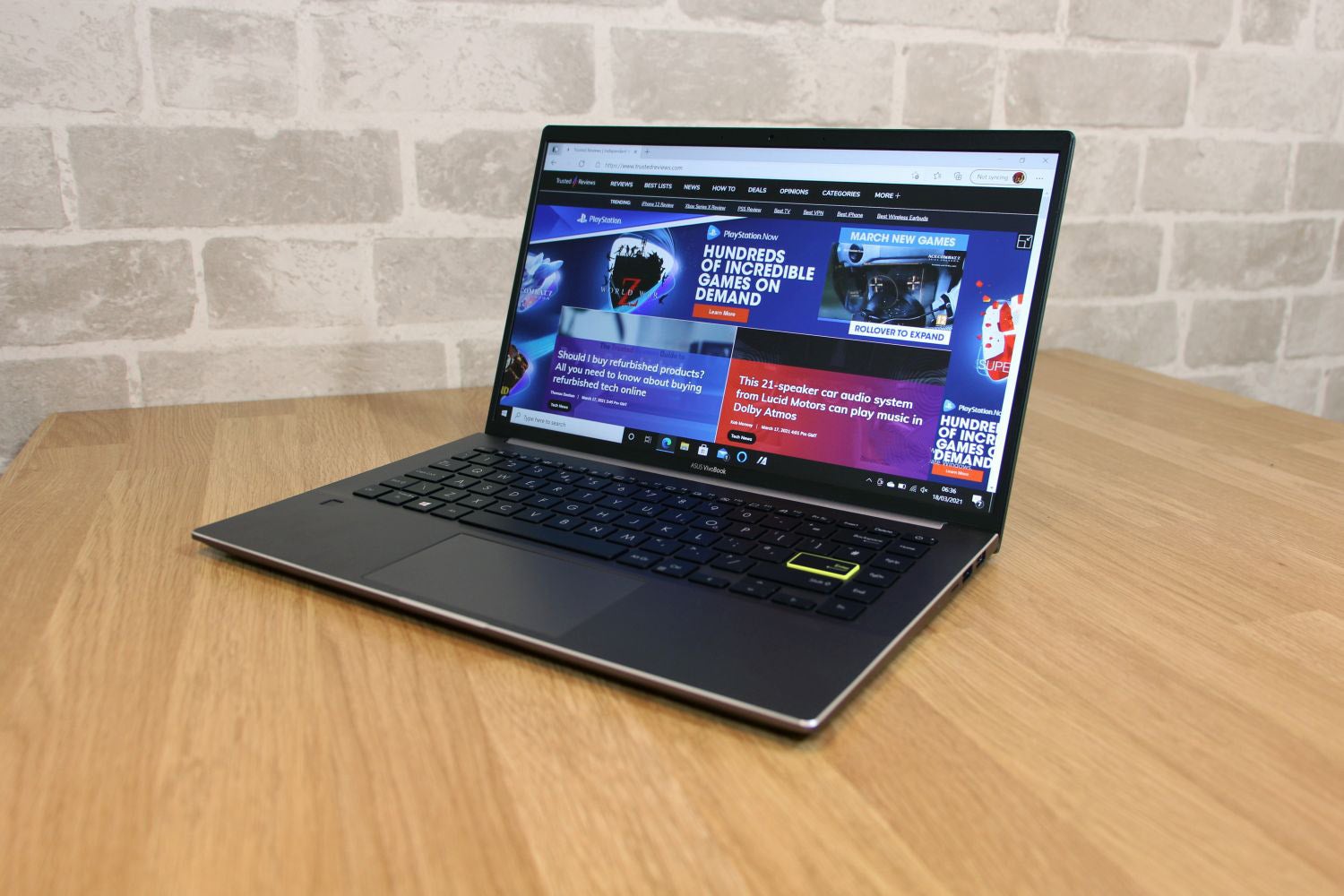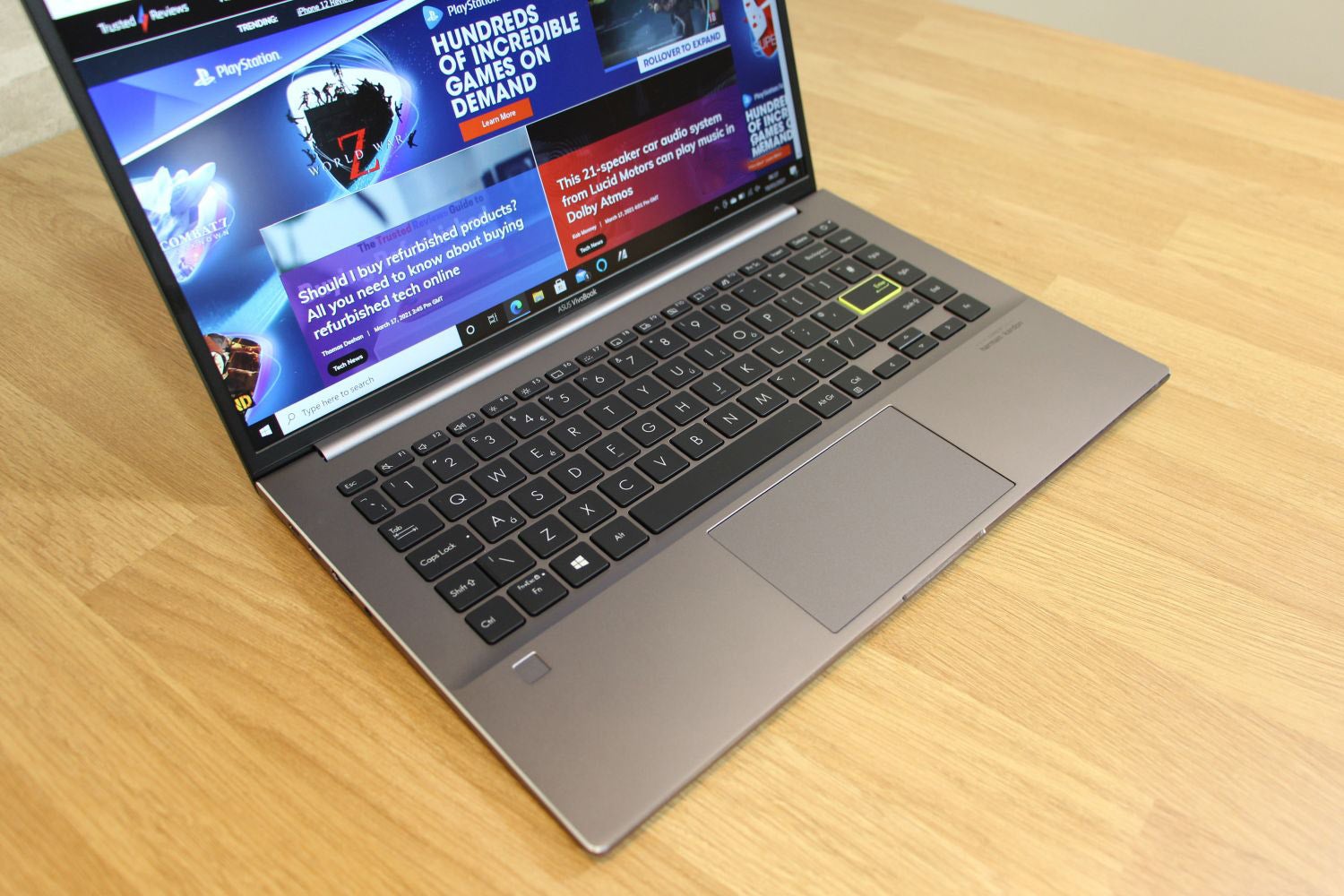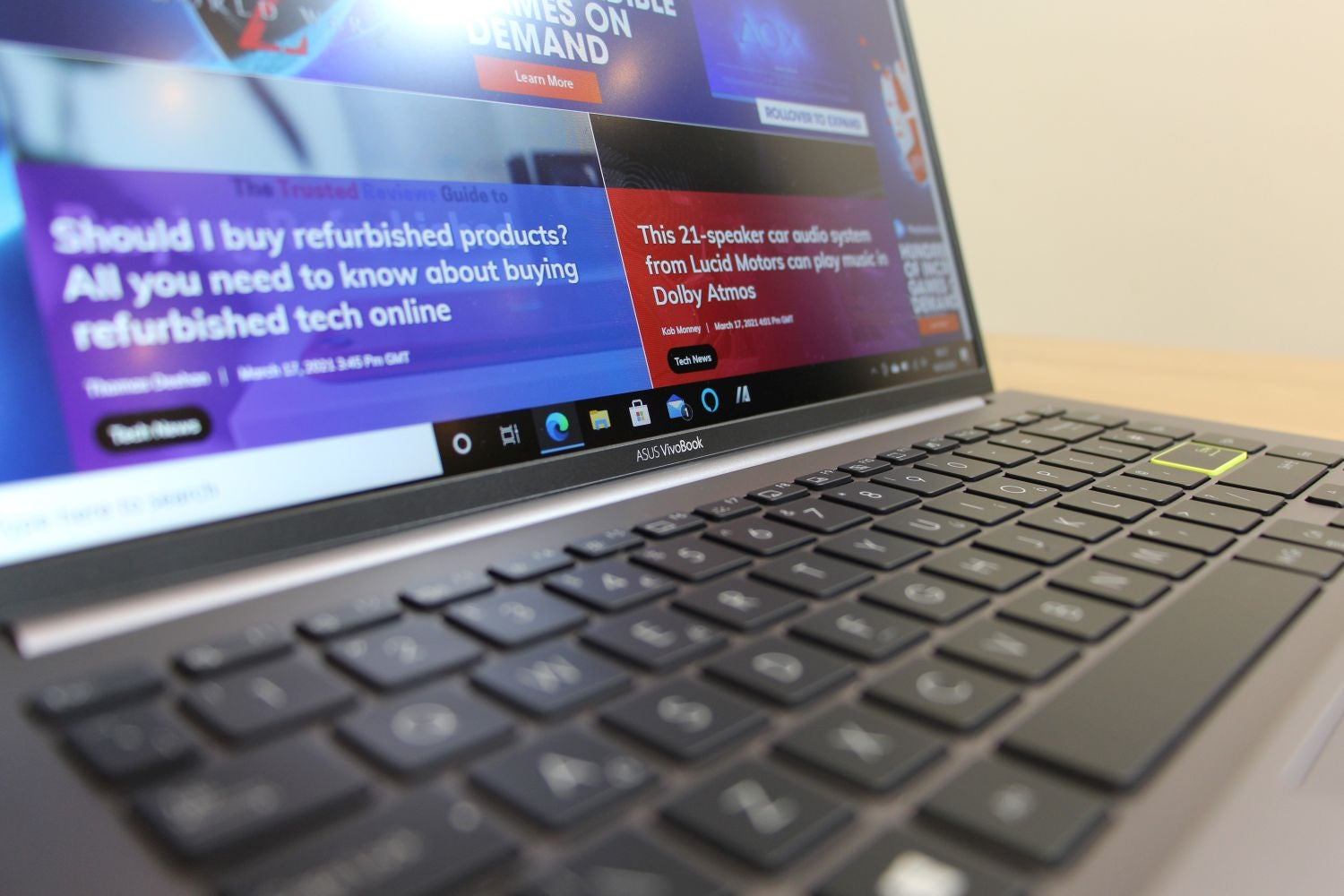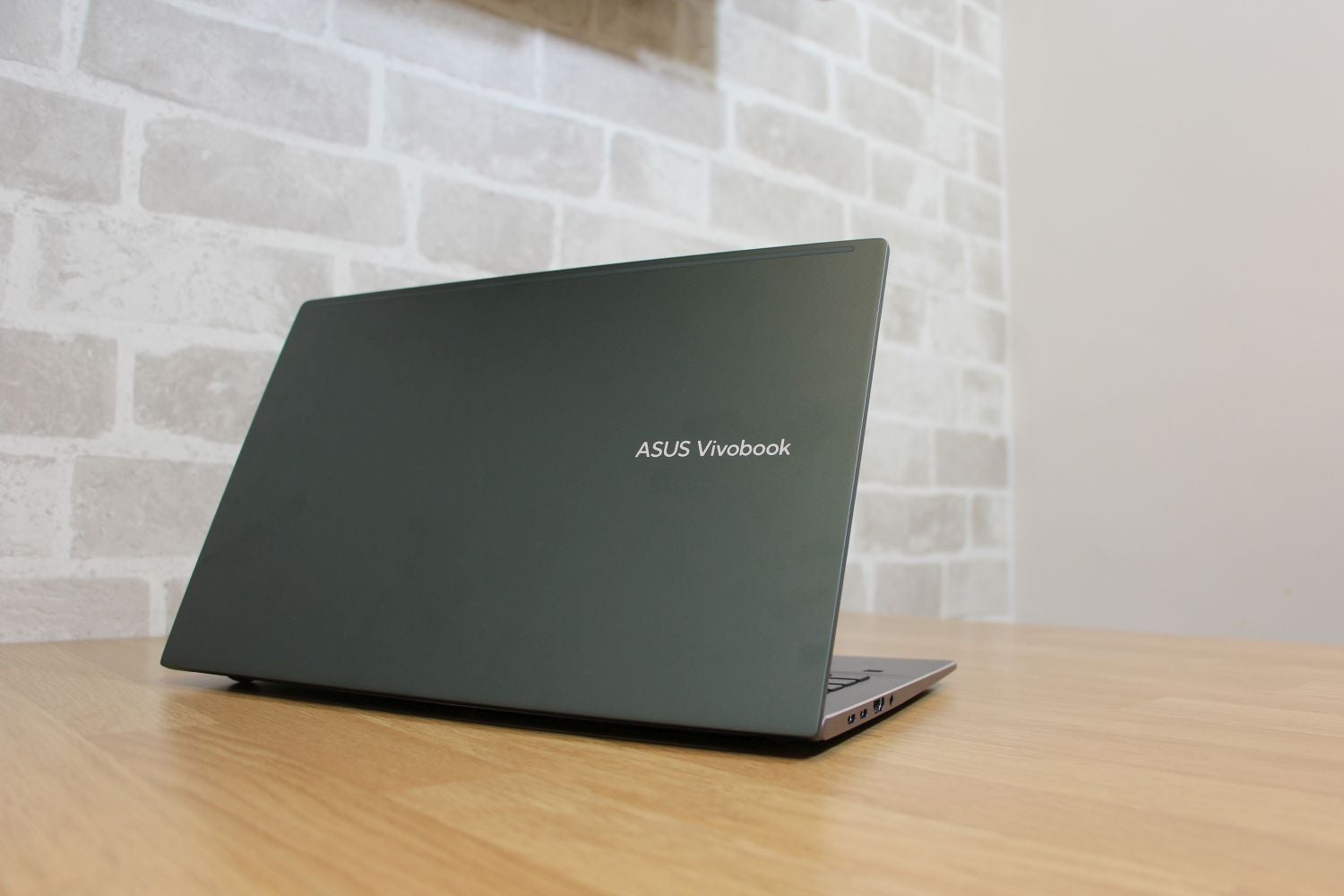Asus VivoBook S14 (S435EA) Review
Asus VivoBook S14 (S435EA) Review
An affordable Ultrabook with a superb battery life
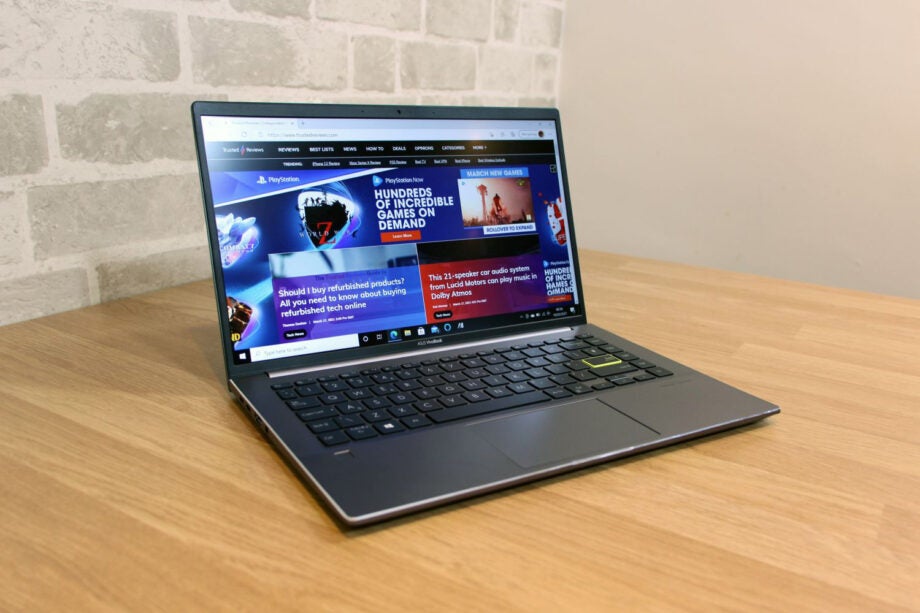
Verdict
The Asus VivoBook S14 is compact, well built and good looking, and it pairs a solid 1080p screen with a reasonable everyday processor and great battery life. It's easy to find more processing power elsewhere, though, and the keyboard is loud and feels a little harsh.
Pros
- Good-looking, sturdy exterior
- Fantastic battery life
- Screen delivers solid quality
- Core i5 processor provides reasonable power
Cons
- Missing important features
- CPU is outpaced by rival chips
- The keyboard is loud and clicky
Key Specifications
- Review Price: £749
- 14in 1920 x 1080 IPS display
- Intel Core i7-1165G7
- Intel Iris Xe graphics
- 8GB DDR4 RAM
- 512GB SSD
- Dimensions: 322 x 204 x 15.9mm
- Weight: 1.3kg
The Asus VivoBook S14 is a small, affordable laptop that looks more stylish than most of its rivals – and it beats them when it comes to battery life, too.
The Asus also undercuts its competition at the checkout, while aiming to be slim, light and sturdy enough to take on every scenario while providing solid performance. It’s a lot to promise for not much money, but can the Asus VivoBook deliver?
Price and availability
The model reviewed is the entry-level VivoBook. It comes with an Intel 11th-Gen Core i5 processor, and it costs £749 / $749. A model with a Core i7 processor is also available, costing £849 / $879 / €799, but this model is available only in Europe at the time of writing.
One word of warning: the model reviewed here uses the UX435EA part number, but the previous generation machine is also still available using the UX433 designation. Those laptops include Intel 10th-Gen processors, wider bezels and no fingerprint reader, so make sure you’re getting the more up-to-date notebook.
Design and keyboard – Good looking, robust and a solid range of features
- The S14 looks great and has some bold, modern touches
- Build quality is generally good, and it isn’t too heavy
- There are decent features here, but power-users won’t be sated
The VivoBook S14 does a fantastic job at balancing sleek design with bolder touches. On the luxurious side, it has crisp bevelled edges, small bezels and plenty of gunmetal aluminium. On the gregarious side, the Asus serves up an eye-catching deep-green lid, a neon-bordered Return key, and sheets of stickers for personalisation.
The bold look is paired with reasonable build quality and dimensions. The wrist-rest rattles a touch, but the display, the base and the sides of this machine are strong enough to handle daily life in and out of the home. The Asus weighs 1.3kg and is 15.9mm thick, so it isn’t overly large.
The Asus compares well with its rivals. The Acer Swift 5 is lighter, but build quality is worse, while the Lenovo Yoga Slim 7 is heavier and more bland.
The left-hand edge of the Asus serves up an HDMI outlet, two Thunderbolt 4/USB-C ports that can charge the machine, and the headphone jack. On the right-hand side, there are two full-size USB ports and a microSD card reader – something the Acer doesn’t include. There’s a fingerprint scanner below the keyboard, too.
In other areas, the VivoBook is less impressive. It has a 720p webcam of mediocre quality, no Windows Hello support and no privacy shutter. One of the USB ports only uses USB 2.0, and there’s no wired internet. Lenovo’s machine is better thanks to its Windows Hello camera and full-size SD card slot.
Not surprisingly, the Asus has no numberpad, a single-height Return key, some extra buttons on the right and smaller function and cursor keys – entirely ordinary stuff for such a petite machine.
The keyboard is consistent and fast. It’s loud, though, and the buttons aren’t soft or gentle. If you like a solid-feeling keyboard, it’s ideal, but the Lenovo is more comfortable. Also bear in mind that the Asus’ backlight is a little weak, and light leaks from beneath some of the buttons.
The VivoBook S14’s trackpad is similar. Its wide surface is smooth and accurate, but its two built-in buttons feel a little hollow when they’re clicked.
Finally, the speakers here are nothing special. They’re fine for YouTube videos and casual music, but the mid-range is muddy and the bass is weak, so don’t rely on these for top-notch sound.
Screen – A punchy, decent everyday display
- The 14in panel provides solid quality for day-to-day workloads
- The high-contrast ratio is punchy and vibrant – great for media
- Lacks the breadth of colour to handle more demanding workloads
The Asus is a mid-range machine, so there are no surprises here: it has a 14in IPS display with a 1920 x 1080 resolution.
For everyday work, web browsing and media viewing those specs are absolutely fine, especially at this price point. In real-world use, TV shows pop, photographs look great and web pages and casual games look punchy and vibrant.
Benchmark results were good, too. The panel’s contrast ratio of 1462:1 is a great result for an IPS display, and the accompanying black level of 0.27 nits means this screen delivers great depth alongside lashings of vibrancy.
The Delta E of 1.37 is solid and the colour temperature of 6277K is reasonable. The Asus rounded out its decent benchmark results with an sRGB coverage level of 96.6%.
That said, the sRGB level isn’t quite good enough for pro-grade workloads, and it couldn’t handle the Adobe RGB and DCI-P3 colour gamuts. The peak brightness of 395 nits is good enough for indoor use, but not bright enough for bright sunlight.
Performance – Everyday speed alongside fantastic battery life
- Intel’s Core i5 chip provides solid mainstream performance
- Rivals include AMD processors that are better for high workloads
The £749 Asus uses a quad-core Intel Core i5-1135G7 processor with base and boost speeds of 2.4GHz and 4.2GHz, and the specification is completed with 8GB of RAM, a 512GB SSD and Intel’s integrated graphics. Dual-band Wi-Fi 6 and Bluetooth 5.0 handle connectivity.
It’s the same specification as the Acer Swift 5, which now costs £899 with the Core i5 chip, but it’s a step behind the Lenovo’s AMD Ryzen 7 4700U.
The VivoBook’s Core i5 chip proved to be comfortably powerful enough to tackle any Office application, lots of browser tabs and mainstream photo-editing without slowdown. Try to take on tougher tasks with this machine, however, and you’ll quickly find its limit. That ceiling is far higher on AMD-powered laptops, and on the MacBook Air – they’re both better options for demanding work.
| Asus VivoBook S14 | Acer Swift 5 | Lenovo Yoga Slim 7 | |
| Processor | Intel Core i5-1135G7 | Intel Core i5-1135G7 | Ryzen 7 4800U |
| Geekbench 5 single | 1390 | 1414 | 1142 |
| Geekbench 5 multi | 5146 | 5378 | 6757 |
| PCMark 10 | 4539 | 4697 | 5159 |
The VivoBook’s benchmark results are on a par with the Intel-based Acer Swift 5, and its single-threaded result beats the Lenovo’s AMD chip – but the Yoga was significantly faster in PCMark 10 and Geekbench’s multi-core test, proving it’s better for demanding workloads.
And, if you’re willing to spend a little more, the entry-level £999 MacBook Air deployed its Apple M1 chip to score 1731 and 7308 in Geekbench, making it the most powerful market currently on the market.
The VivoBook costs £849 with a Core i7-1165G7, but the situation remains the same – while that processor offers a bit more power, AMD’s CPUs and the Apple M1 chip both remain quicker in multi-threaded environments.
So compared to the competition, the VivoBook lags slightly behind the backs in terms of performance power. On the bright side, it’s a good thermal performer, remaining consistently cool and quiet.
The SSD’s read and write speeds of 2455MB/s and 1288MB/s aren’t ground-breaking, but they keep the machine snappy enough in daily use, so data transfers shouldn’t be a tediously lengthy process.
Battery – Fantastic longevity for work and play
- Superb battery life helps the Asus outlast the competition
The Asus might not offer great power, but it does have stellar battery life. With the brightness set to 150 nits and a PCMark 10 work test running, the Asus lasted for 15hrs 48mins – that’s 20 minutes more than the Acer Swift, and an hour better than the Lenovo.
This laptop returned a virtually identical time when playing video with the screen at 150 nits, and the Asus still lasted a mighty 12hrs 47mins in a work benchmark with the screen brightness at maximum. The VivoBook lasted for 3hrs 11mins with the components really pushed, but you’re unlikely to run everything at 100% on this machine.
It’s an impressive slate of results. If you’re careful about how you use the Asus then it will almost get through two whole workdays, and it’s easily capable of handling a day of work and a night on the sofa. It’s better than both rivals, too.
Asus VivoBook S14 conclusion
The Asus Vivebook is a great Ultrabook, excelling at the basics with a well-built design, solid 1080p display and superb battery life. But while this laptop is certainly no slouch, there are faster alternatives – such as the Acer Swift 5 and Lenovo Yoga Slim 7 – available at similar price points.
I’m also disappointed by the keyboard, which is loud and feels harsh compared to those found on other laptops. That said, if you’re impressed by the battery life and eye-catching design, this is still a great value laptop worth considering.
You should buy the Asus VivoBook S14 if…
- You want a laptop that looks better than most affordable notebooks
The combination of a sleek aluminium exterior and a couple of surprisingly colourful touches make the VivoBook stand out in a market filled with laptops that all look a bit too similar.
- You need something slim, light and sturdy
The Asus weighs 1.3kg, it’s less than 16mm thick, and it has a sturdy chassis that will survive being slung into a bag. It’s a robust laptop that will cope with all of your everyday situations.
- Battery life is an important consideration
The Asus lasts for nearly 16 hours in some of our battery tests, which is a brilliant result and better than the competition. If you need a long-lasting laptop, this is a great choice.
You shouldn’t buy the Asus VivoBook S14 if…
- You need a laptop for tougher work situations
The Intel processor is a solid everyday chip, but AMD’s Ryzen CPUs and the Apple M1 processor are both far better in tough work applications.
- You like a soft, quiet keyboard
The keyboard is fast and crisp, but it’s louder and isn’t as soft as many other rival typing units. If you want a harsher-feeling typing experience that’s great, but this unit is neither subtle nor gentle.
- You want to play games
Intel’s integrated graphics core is fine for casual gaming and low-end eSports titles, but that’s it – it won’t play anything demanding. You’ll need Nvidia or AMD graphics for that.
How we test laptops
Unlike other sites, we test every laptop we review thoroughly over an extended period of time. We use industry standard tests to compare features properly. We’ll always tell you what we find. We never, ever, accept money to review a product.


